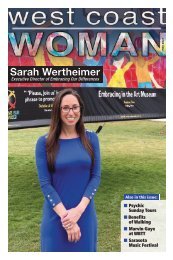West Coast Woman October 2020
WCW’s October issue has lots to read and explore! Our WCW this month is Kendra Simpkins who works with veterans. It’s our Women’s Health issue, so we have articles and features on staying healthy and eating right. You’ll enjoy our Travel News column with its many offers and deals on travel within Florida. Plus we have our calendar that list health lectures, club meetings and more. Out & About has cultural events in Sarasota and Bradenton ANF a writeup on Artist Series Concerts next concerts. Finally, don’t miss our WCW Foodie column where we have news on the restaurant scene. Enjoy and please stay well!
WCW’s October issue has lots to read and explore! Our WCW this month is Kendra Simpkins who works with veterans. It’s our Women’s Health issue, so we have articles and features on staying healthy and eating right. You’ll enjoy our Travel News column with its many offers and deals on travel within Florida. Plus we have our calendar that list health lectures, club meetings and more. Out & About has cultural events in Sarasota and Bradenton ANF a writeup on Artist Series Concerts next concerts. Finally, don’t miss our WCW Foodie column where we have news on the restaurant scene. Enjoy and please stay well!
Create successful ePaper yourself
Turn your PDF publications into a flip-book with our unique Google optimized e-Paper software.
your health<br />
HOW DOES<br />
OBESITY CAUSE CANCER?<br />
The link between obesity and cancer risk is clear.<br />
What’s less clear is how exactly one leads to the other<br />
THE LINK BETWEEN<br />
obesity and cancer risk is<br />
clear. Research shows that<br />
excess body fat increases<br />
your risk for several cancers, including<br />
colorectal, post-menopausal<br />
breast, endometrial, esophageal,<br />
kidney and pancreatic cancers.<br />
What’s less clear is exactly how<br />
being obese increases that risk.<br />
Experts believe it’s largely due to<br />
the inflammation caused by visceral<br />
fat – the fat that surrounds your<br />
vital organs.<br />
“The problem with excessive visceral<br />
fat is that it affects certain processes<br />
in your body. This includes<br />
how your body manages hormones,<br />
like insulin and estrogen,” says Adriana<br />
Coletta, Ph.D. RD, a postdoctoral<br />
fellow in cancer prevention.<br />
“All of this can lead to an increased<br />
cancer risk by affecting<br />
how and when cells divide and die,”<br />
she says.<br />
How does obesity<br />
cause inflammation?<br />
Visceral fat cells are large, and<br />
there are a lot of them. This excess<br />
fat doesn’t have much room for<br />
oxygen. And that low-oxygen environment<br />
triggers inflammation.<br />
Inflammation is the body’s natural<br />
response to injury and disease. For<br />
example, when you get a deep cut,<br />
the area around the cut becomes<br />
red and painful to touch. This minor<br />
inflammation around the wounded<br />
area helps repair the damaged tissue<br />
and aids with the healing process.<br />
But long-term inflammation<br />
caused by excess visceral fat can<br />
damage your body and increase<br />
your risk for cancer.<br />
Cancer happens when cells reproduce<br />
uncontrollably, damaging<br />
the cells around them and causing<br />
illness. The more cells divide and<br />
reproduce, the higher the risk that<br />
something will go wrong and a tumor<br />
will form.<br />
Inflammation<br />
and insulin<br />
The link between inflammation<br />
and insulin – the hormone that<br />
regulates blood sugar – is complex,<br />
Coletta says.<br />
Inflammation caused by obesity<br />
can keep the body from properly<br />
responding to insulin. This is called<br />
insulin resistance. When the body<br />
doesn’t respond to insulin correctly,<br />
it produces more insulin to<br />
make up for that.<br />
The increase in insulin due to insulin<br />
resistance triggers an increase<br />
in the number of cells produced,<br />
which can lead to cancer. “Increased<br />
insulin also affects how hormones<br />
like estrogen are controlled,” says<br />
Coletta. “More insulin can lead to<br />
more available estrogen, which increases<br />
cancer risk.”<br />
How does more<br />
estrogen increase<br />
cancer risk?<br />
“Basically, higher estrogen levels<br />
lead to increased cell production,<br />
which could result in tumor<br />
growth,” Coletta says. Estrogen<br />
is necessary for the body to function.<br />
In women, the ovaries are<br />
the main source of estrogen. In<br />
men, an enzyme converts testosterone<br />
to estrogen. But fat cells<br />
in both men and women can also<br />
make estrogen. This is why too<br />
much estrogen is commonly seen<br />
in obesity.<br />
In women, too much estrogen<br />
is linked to an increased risk for<br />
post-menopausal breast, endometrial<br />
and ovarian cancers.<br />
Cancer and obesity:<br />
What you can do?<br />
One of the most important things<br />
you can do to decrease your cancer<br />
risk is maintain a healthy weight,<br />
Coletta says.<br />
There are steps you can take<br />
to prevent obesity:<br />
• Stay active. Aim for 150 minutes<br />
of moderate activity or 75 minutes<br />
of vigorous activity a week.<br />
• Eat a healthy diet. Fill at least<br />
2/3 of your plate with non-starchy<br />
vegetables, fruit, whole grains or<br />
legumes (beans and peas), and<br />
1/3 or less with animal protein.<br />
• If you drink alcohol, limit<br />
yourself to one drink per day if<br />
you are a woman, and two per<br />
day if you are a man.<br />
• Get plenty of rest. Fatigue can<br />
make you want to eat more, and<br />
make unhealthy choices.<br />
Being obese or overweight hurts<br />
your body’s ability to work well,<br />
Coletta says. Maintaining a healthy<br />
weight is essential for reducing<br />
your risk for cancer.<br />
SOURCE: AICR<br />
How to determine<br />
calorie burn<br />
Of course exercise burns calories,<br />
but which exercises burn the most?<br />
And how do you know? We all<br />
know that when it comes to weight<br />
loss and energy balance, it’s a matter<br />
of calories in versus calories<br />
out. But when you exercise, do you<br />
really know how many calories<br />
you’re burning?<br />
It’s important to learn how many<br />
calories you typically burn so you<br />
can control your weight, prevent<br />
obesity and lower your cancer risk.<br />
Here are some answers to<br />
typical questions:<br />
How do you know how<br />
many calories you’ve<br />
burned during a workout?<br />
Measuring the exact number of<br />
calories you burn can be difficult.<br />
There are a few ways to measure<br />
your calorie burn. You can:<br />
• Use an activity tracker or an<br />
app that will estimate your calorie<br />
burn for you. But be careful<br />
with these. The accuracy can<br />
vary from product to product.<br />
• A heart rate monitor is one of<br />
the best ways to measure your<br />
calorie burn. Your heart rate indicates<br />
how much effort it takes<br />
for you to do a certain activity,<br />
and that effort determines the<br />
calories you burn. If a heart rate<br />
monitor indicates your calorie<br />
burn, it’s more likely to be accurate<br />
than the average activity<br />
tracker because it’s taken your<br />
specific heart rate in to account.<br />
• A MET values chart can also<br />
show you how many calories<br />
are typically burned during<br />
specific activity based on your<br />
weight. This chart was created<br />
by researchers and used<br />
widely throughout the medical<br />
community.<br />
Which helps you lose more<br />
weight: diet or exercise?<br />
Diet. Cutting calories and eating<br />
healthy will help you lose weight.<br />
Exercise alone probably won’t help<br />
you lose weight, but it will help you<br />
keep the weight off.<br />
To lose one pound a week you<br />
should aim for a calorie deficit of<br />
500 calories per day, through a combination<br />
of reducing the calories<br />
you eat and increasing the calories<br />
you burn through physical activity.<br />
This adds up to 3,500 calories per<br />
week, the number of calories in<br />
about one pound of fat.<br />
What factors contribute<br />
to how many calories<br />
are burned?<br />
Several factors contribute to how<br />
quickly an individual burns calories,<br />
including:<br />
• The intensity of an activity being<br />
performed. The more intense<br />
an activity is the more calories<br />
an individual burns.<br />
• Weight. People who weigh more<br />
burn more calories.<br />
• Body composition. Muscle<br />
requires more energy than fat to<br />
maintain. People with more muscle<br />
burn more calories.<br />
How much activity<br />
do I need to do?<br />
To lower your cancer risk, aim for<br />
at least 150 minutes of moderate<br />
physical<br />
activity or<br />
75 minutes<br />
of vigorous<br />
activity<br />
each<br />
week.<br />
Remember,<br />
you<br />
don’t have<br />
to do it all<br />
at once.<br />
You can<br />
break it up<br />
throughout<br />
the<br />
day, too.<br />
SOURCE:<br />
MD<br />
Anderson<br />
Cancer<br />
Center<br />
20 WEST COAST WOMAN OCTOBER <strong>2020</strong>

















